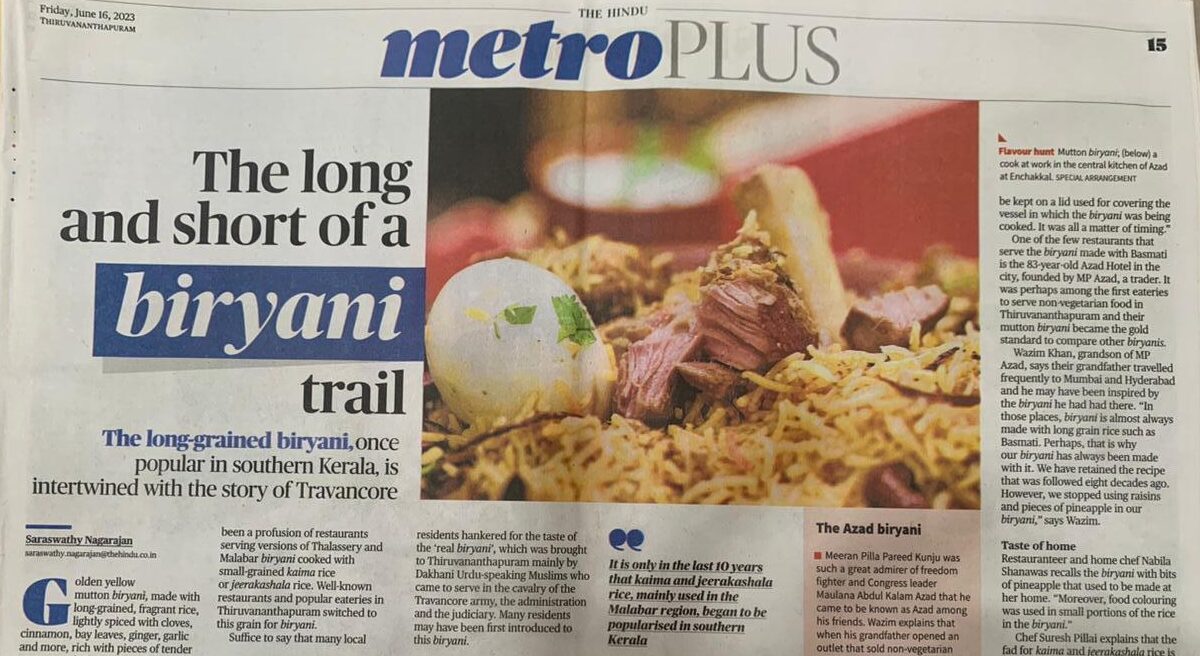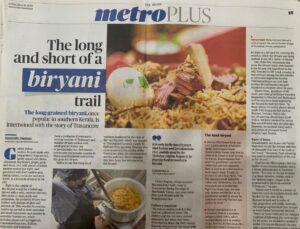
The Hindu: The long-grained biryani, once popular in southern Kerala, is intertwined with the story of Travancore
Saraswathy Nagarajan
saraswathy.nagarajan@thehindu.co.in
Golden yellow mutton biryani, made with long-grained, fragrant rice, lightly spiced with cloves, cinnamon, bay leaves, ginger, garlic and more, rich with pieces of tender mutton cooked just right, and garnished with fried cashew nuts, plump raisins, coriander, and mint leaves, is a favorite of many in the city.
Right in the middle of the biryani would be a boiled egg. Served with a raita, coconut chutney, lime pickle or date pickle and pappadam, the aromatic biryani was cooked with dollops of ghee and coconut oil. This was the biryani that used to be served in most upmarket and small restaurants and eateries in erstwhile Travancore, which included places such as Nagercoil, Thiruvananthapuram, Kollam, Alappuzha and Kottayam.
Over the last decade, there has been a profusion of restaurants serving versions of Thalassery and Malabar biryani cooked with small-grained kaima rice or jeerakashala rice. Well-known restaurants and popular eateries in Thiruvananthapuram switched to this grain for biryani.
Suffice to say that many local residents hankered for the taste of the ‘real biryani, which was brought to Thiruvananthapuram mainly by Dakhani Urdu-speaking Muslims who came to serve in the cavalry of the Travancore army, the administration and the judiciary. Many residents may have been first introduced to this biryani.

“It is only in the last 10 years that kaima and jeerakashala rice, mainly used in the Malabar region, began to be popularised in southern Kerala”
- SURESH PILLAI Chef and restauranteur
Chand Begum, whose ancestor Murtaza Khan Saab, came to Travancore during the reign of Marthanda Varma, says even today they cook biryani with long-grained rice.
Culinary tradition
“My amma used to cook it in the open on a firewood stove. The mutton and the rice were cooked separately and when they were three-fourths done, the rice, usually Basmati, was put into the vessel with the mutton. Then the fire in the stove would be reduced and coals would be kept on a lid used for covering the vessel in which the biryani was being cooked. It was all a matter of timing.”
One of the few restaurants that serve biryani made with Basmati is the 83-year-old Azad Hotel in the city, founded by MP Azad, a trader. It was perhaps among the first eateries to serve non-vegetarian food in Thiruvananthapuram and their mutton biryani became the gold standard to compare other biryanis.
Wazim Azad, grandson of MP Azad, says their grandfather travelled frequently to Mumbai and Hyderabad and he may have been inspired by the biryani he had had there. “In those places, biryani is almost always made with long grain rice such as Basmati. Perhaps, that is why our biryani has always been made with it. We have retained the recipe that was followed eight decades ago. However, we stopped using raisins and pieces of pineapple in our biryani,” says Wazim.
The Azad biryani
- Meeran Pilla Pareed Kunju was such a great admirer of freedom fighter and Congress leader Maulana Abdul Kalam Azad that he came to be known as Azad among his friends. Wazim explains that when his grandfather opened an outlet that sold non-vegetarian food, it used to be called Azadinte kada (Azad’s shop). Finally, he decided to call it Azad Hotel. “He first opened a small makeshift outlet near Vallakadavu. Our first restaurant was at Overbridge. Right from those days, we sold only mutton and chicken as my grandfather wanted to assure his customers that only the best was sold at his hotel.”
- At their central kitchen at Enchakkal, there is a separate category called 1940’s, which includes dishes such as mutton chops, liver fry, mutton soup, etc., which have been a constant on their menu from 1940.
Taste of home
Restauranteur and home chef Nabila Shanawas recalls the biryani with bits of pineapple that used to be made at her home. “Moreover, food colouring was used in small portions of the rice in the biryani.”
Chef Suresh Pillai explains that the fad for kaima and jeerakashala rice is a recent phenomenon in Southern Kerala. “It is only in the last 10 years that these varieties, mainly used in the Malabar region, began to be popularised in places in erstwhile Travancore,” he says.
Wazim says it could be a matter of taste but many in Southern Kerala still hanker for the taste of the Basmati biryani and its sides of egg, pappadam and pickle. Recently, the Azad group branded their biryani as Azad Pukka Travancore Biriyani. “Since we have continued the culinary tradition of following the same recipe for 80 years, we decided to market it as the Travancore Biriyani.” He says with a laugh that many make a beeline to Azad for the taste of nostalgia and to feast on biryani.

